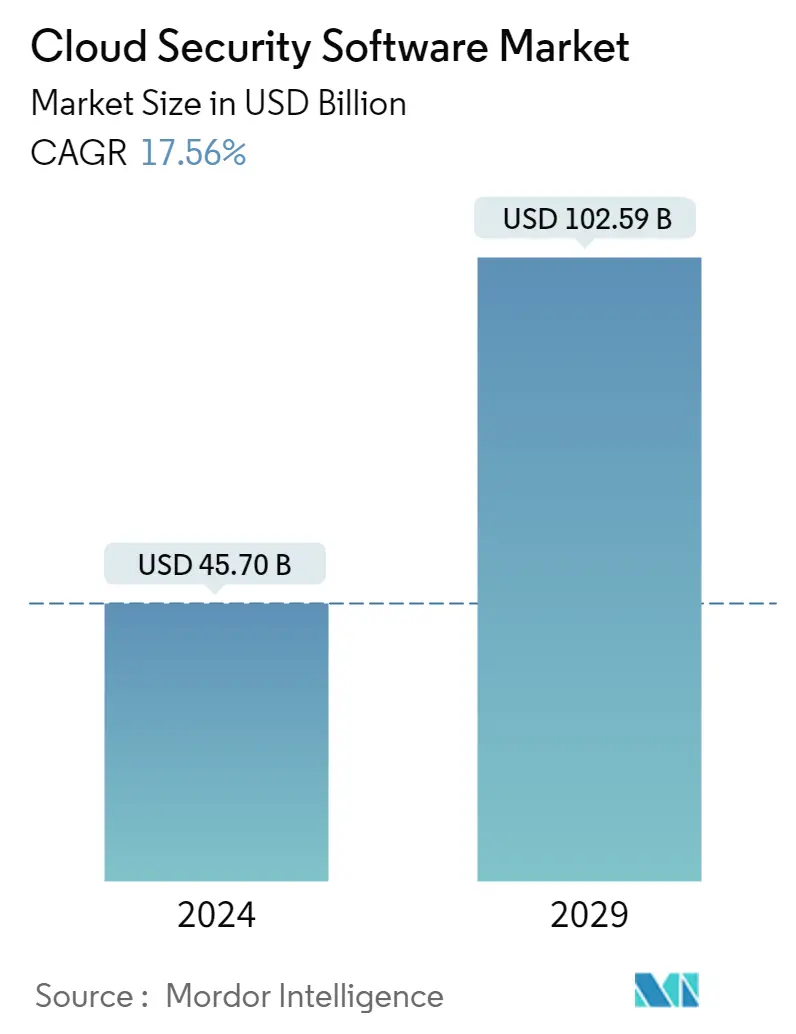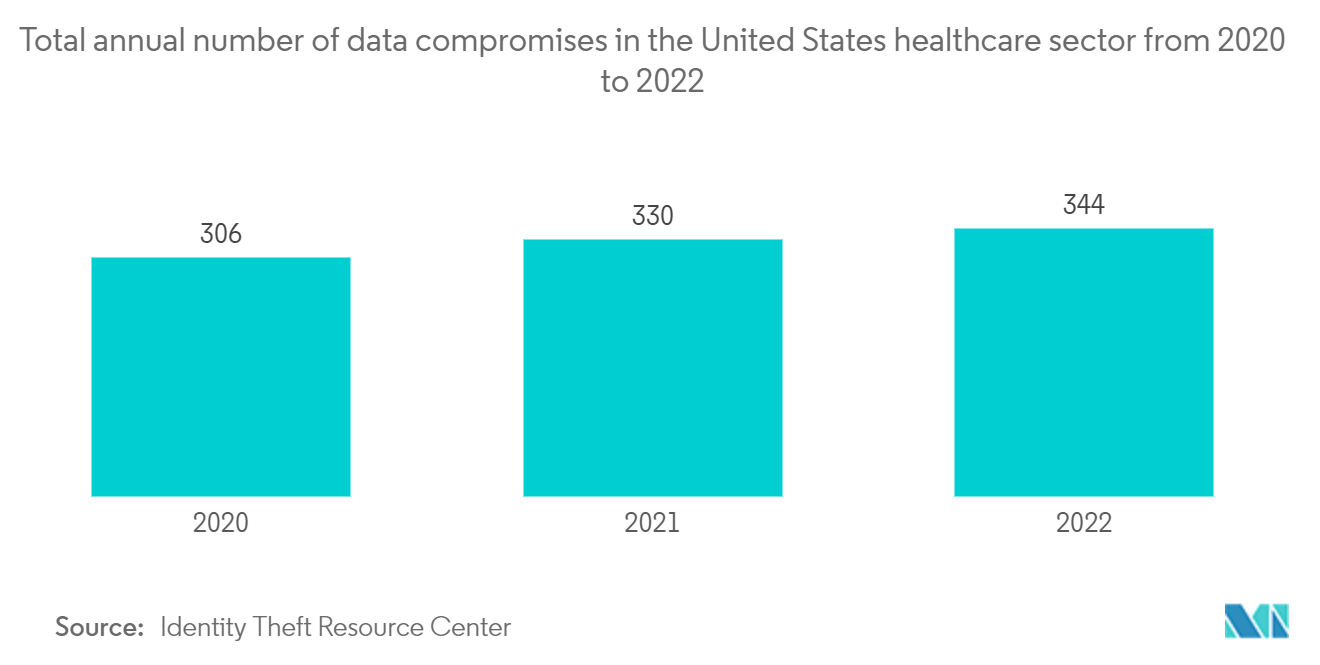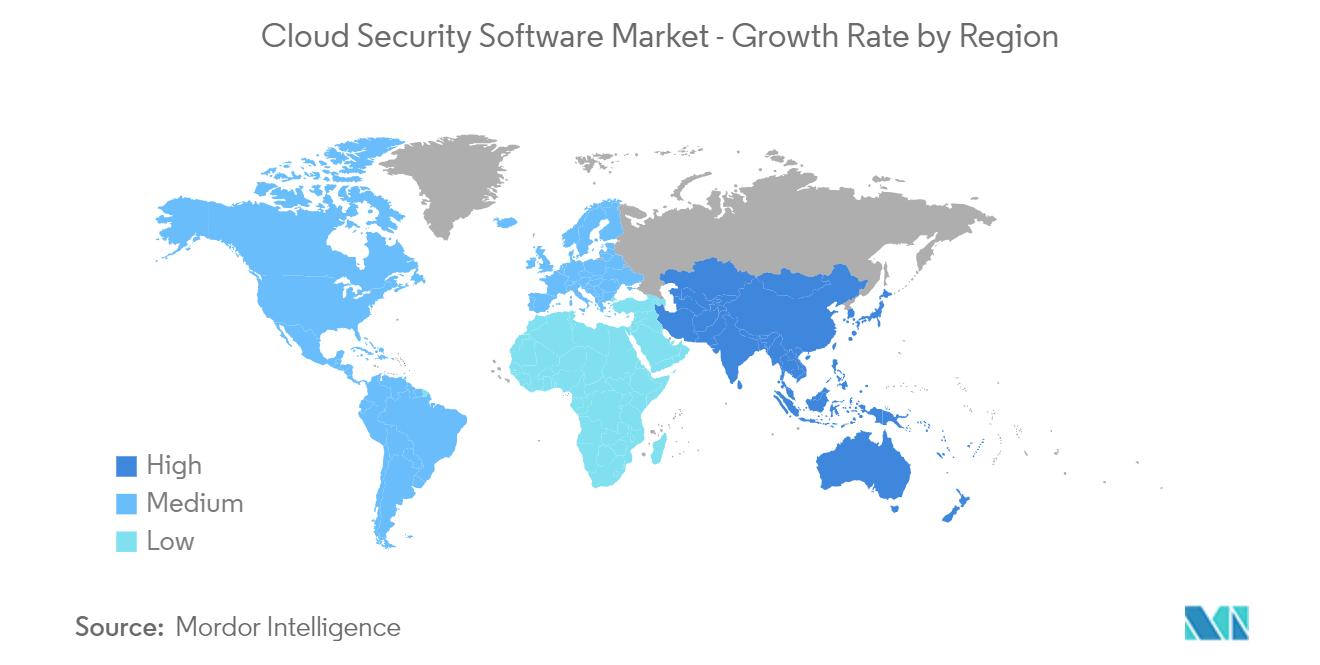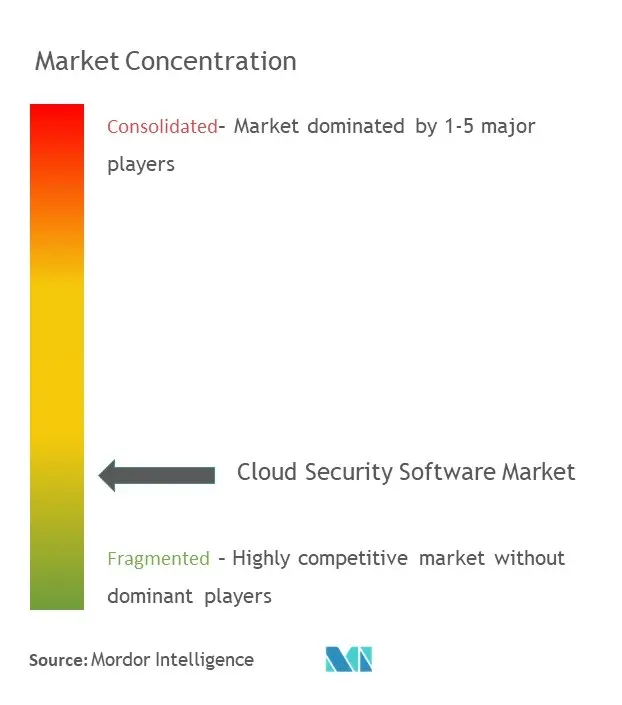Cloud Security Software Market Size

| Study Period | 2019 - 2029 |
| Market Size (2024) | USD 45.70 Billion |
| Market Size (2029) | USD 102.59 Billion |
| CAGR (2024 - 2029) | 17.56 % |
| Fastest Growing Market | Asia Pacific |
| Largest Market | North America |
| Market Concentration | Low |
Major Players
*Disclaimer: Major Players sorted in no particular order |
Cloud Security Software Market Analysis
The Cloud Security Software Market size is estimated at USD 45.70 billion in 2024, and is expected to reach USD 102.59 billion by 2029, growing at a CAGR of 17.56% during the forecast period (2024-2029).
- The growing data generation and increasing complexity of technologies have resulted in a heavy dependence of organizations on cloud services for operations and data management. This growth in the adoption of cloud services directly impacts the demand for cloud security solutions.
- Cloud technology and cloud-based resources help mitigate the rise in lethal cyber-security threats. Cloud security requires a set of policies and controls vital for the security of applications, infrastructure, and data. Threats, such as data loss, breaches, and insecure application programming interfaces (API), are frequent on the cloud computing platform. The evolution of the cyber environment and related technologies paved the way for new threats. Cyber-attacks are highly targeted, persistent, and technologically advanced.
- The BFSI industry is one of the critical infrastructure segments that face multiple data breaches and cyber-attacks, owing to the massive customer base that the sector serves and the financial information that is at stake. Cybercriminals are leveraging an abundance of harmful cyberattacks to immobilize the financial industry since it is a highly lucrative operating model with the added benefit of relatively low risk and detectability. These attacks' threat landscape ranges from Trojans, malware, ATM malware, ransomware, mobile banking malware, data breaches, institutional invasion, data thefts, fiscal breaches, etc.
- Vendors offering security solutions are actively involved in collaborating with other managed security service providers. For instance, in October 2022, Google Cloud declared a significant extension of its trusted cloud ecosystem. It highlighted new integrations and offerings with more than twenty partners focused on enabling more excellent data sovereignty controls, assisting Zero Trust models, unifying identity management, and improvising endpoint security for global businesses.
- However, factors like integrating various complexities with legacy infrastructure could limit the market's overall growth throughout the forecast period.
- Due to the outbreak of COVID-19, the cloud security market grew significantly. It was expected to witness massive growth during the post-COVID-19 period as cloud-based services and tools were increasingly adapted due to organizations deploying remote work access amid lockdowns in different countries. The rise in the usage of cloud-based services during this pandemic became a hotspot for cyberattacks as millions worked in unfamiliar, less secure circumstances. Thus, a cloud security solution played a vital role during this pandemic and is expected to witness a surge.
Cloud Security Software Market Trends
Healthcare Sector to Witness the Significant Growth
- Healthcare organizations have become more distributed, owing to remote clinical offices, trial sites, rehab facilities, outsourcing, and off-site workers, leading each office and individual to require unique yet seamless access to applications and resources via various devices. Healthcare organizations recognize the benefits provided by cloud technology, such as greater flexibility, scalability, and availability of systems and applications.
- With advancements in healthcare, such as electronic medical records and other patient details being registered with the respective hospitals, the potential vulnerability for the data has been increasing, owing to which the implementation of network security has been of primary importance.
- Using AI, data-driven security monitoring, and behavioral analytics makes cloud-based security more effective. For instance, Microsoft's integrated intelligent security graph collects billions of data points daily and uses machine learning and AI to analyze and identify evolving cybersecurity attacks.
- In April 2022, the U.S. Food and Drug Administration published a draft guidance, Cybersecurity in Medical Devices, Content of Premarket Submissions and Quality System Considerations, regarding medical device cybersecurity. The draft guidance emphasizes safeguarding medical devices throughout a product's life cycle. These recommendations can enable an efficient premarket review process and help assure that marketed medical devices are sufficiently resilient to cybersecurity threats.
- According to May 2023 Healthcare Data Breach Report, most of the month's data breaches were hacking IT incidents, many of which were ransomware attacks and data theft or extortion attempts. Around 81.33% of the month's data breaches were hacking, and IT incidents, and those incidents accounted for approximately 99.54% of all breached records. The protected health information of about 18,956,101 individuals was exposed or stolen in those incidents. The average data breach size was 310,756 records, and the median breach size was 3,833.

The Asia-Pacific to Witness the Highest Growth
- Due to the rise in the usage of various IoT devices and the increasing scope and speed of digital transformation in the Asia-Pacific region, the current network infrastructure is becoming widely exposed to cyberattacks. Social media, internet, and mobile users have all seen a drastic rise in recent years, contributing to the region's strong growth in cybersecurity. This is expected to fuel the market growth opportunity within the region throughout the forecast period.
- Moreover, the region's various governments are imposing new cybersecurity laws to reduce the impact of cyber phishing, malware, and other cybersecurity threats. For instance, South Korea's ICT ministry announced the plan to spend KRW 670 billion (USD 607 million) by 2023 to bolster the country's cybersecurity capabilities to respond to growing new digital threats. The country plans to develop infrastructure to quickly respond to cybersecurity threats by collaborating with major cloud and data center companies to collect threat information in real time, compared to the current system that relies on individual reports.
- Recently, there have been multiple attacks on Indian power grids by China. In April 2022, India's power sector was targeted by hackers in a long-term operation. The group primarily utilized the trojan ShadowPad, which is believed to have been developed by the contractors for China's Ministry of State Security.
- Also, due to the rise in technological advancements, there is an increase in the number of connected devices in China. It is a significant Internet of Things (IoT) market globally. Furthermore, 5G and 5G-enabled devices exponentially increase the devices' interconnectivity. As a result, it increases the overall adaptability of the connected devices, thereby directly augmenting the need for security products in the market. Moreover, the websites are thereby prone to be manipulated and impersonated by third parties, and sensitive user data communicated with the website can be intercepted more easily by foreign intelligence agencies.
- In July 2023, Sangfor Technologies Co., Ltd., a provider of IT infrastructure solutions specializing in Cloud Computing & Network Security, and Cloudsec Asia Co., Ltd., a provider of cloud security and cyber security services in Thailand, formed a strategic partnership primarily to deliver comprehensive managed services for cyber threat detection. The collaboration between Sangfor Technologies and Cloudsec Asia targets to address the rising demand for effective cyber threat management within business organizations. By leveraging their expertise, the companies would deliver a managed service that empowers organizations to proactively mitigate and detect cyber threats while overcoming challenges like time constraints, limited resources, and technological complexities associated with cybersecurity management.

Cloud Security Software Industry Overview
The market for cloud security software is fragmented due to the rise in cyber-attacks over the years. Enterprises have become more aware and careful regarding their data stored in the cloud. Thus, they offer offerings from NortonLifeLock Inc. (Broadcom Inc.), CA Technologies (Broadcom Inc.), Microsoft Corporation, Armor Defense Inc., etc.
In April 2023, Uptycs, the provider of the first unified CNAPP and XDR platform, declared the ability to collect and analyze GitHub audit logs and user identity information from Okta and Azure Active Directory to reveal suspicious behavior as the developer moves code in and out of repositories and into production. The result is an "early warning system" that enables the security teams to identify and stop threat actors before they can access the cloud's crown jewel data and services.
Cloud Security Software Market Leaders
-
CA Technologies (Broadcom Inc.)
-
Trend Micro, Inc.
-
Check Point Software Technologies
-
Armor Defense Inc.
-
IBM Corporation
*Disclaimer: Major Players sorted in no particular order

Cloud Security Software Market News
- April 2023: Accenture and Google Cloud declared an extension of their global partnership to support and assist businesses in better protecting critical assets and strengthening overall security against persistent cyber threats. Together, they are delivering the technology, security expertise, and trusted infrastructure organizations need to build and create resilient security programs and maintain confidence in their readiness.
- In April 2023, LogRhythm, the company empowering security teams to navigate the ever-changing threat landscape, declared its partnership with Zscaler, the cloud security provider. LogRhythm and Zscaler work together to support and assist organizations throughout the globe to maximize network insight and address a wide variety of cloud access security challenges faced by the modern SOC. LogRhythm SIEM and the Zscaler Zero Trust Exchange platform deliver unparalleled visibility and security to facilitate a modern Zero Trust architecture.
Cloud Security Software Market Report - Table of Contents
1. INTRODUCTION
1.1 Study Assumptions & Deliverables
1.2 Scope of the Study
2. RESEARCH METHODOLOGY
3. EXECUTIVE SUMMARY
4. MARKET DYNAMICS
4.1 Market Overview
4.2 Industry Attractiveness - Porter's Five Forces Analysis
4.2.1 Bargaining Power of Suppliers
4.2.2 Bargaining Power of Buyers/Consumers
4.2.3 Threat of New Entrants
4.2.4 Threat of Substitutes
4.2.5 Intensity of Competitive Rivalry
4.3 An Assessment of the Impact and Recovery from COVID-19 on the Industry
5. MARKET DYNAMICS
5.1 Market Drivers
5.1.1 Adoption of Digital Transformation Practices
5.1.2 Growing Use of Digital Services Through Mobile and Other Devices
5.2 Market Challenges
5.2.1 Integration Complexities with Legacy Infrastructure
5.3 Analysis of Key Innovations and Advancements in Cybersecurity Related Practices
5.4 Key Industry Standards & Frameworks
5.5 Key Use Cases
6. MARKET SEGMENTATION
6.1 By Software
6.1.1 Cloud IAM
6.1.2 Web and Email Security
6.1.3 SIEM
6.1.4 CASB
6.1.5 Vulnerability and Risk Management
6.1.6 Other Software
6.2 By Organization Size
6.2.1 SME
6.2.2 Large Enterprises
6.3 By End User
6.3.1 IT & Telecom
6.3.2 BFSI
6.3.3 Retail & Consumer Goods
6.3.4 Healthcare
6.3.5 Manufacturing
6.3.6 Government
6.3.7 Other end-users
6.4 Geography
6.4.1 North America
6.4.1.1 United States
6.4.1.2 Canada
6.4.2 Europe
6.4.2.1 Gemany
6.4.2.2 United Kingdom
6.4.2.3 France
6.4.2.4 Rest of Europe
6.4.3 Asia-Pacific
6.4.3.1 India
6.4.3.2 China
6.4.3.3 Japan
6.4.3.4 Rest of Asia-Pacific
6.4.4 Latin America
6.4.5 Middle East and Africa
7. COMPETITIVE LANDSCAPE
7.1 Company Profiles
7.1.1 IBM Corporation
7.1.2 Symantec (Broadcom)
7.1.3 Palo Alto Networks
7.1.4 Cisco
7.1.5 McAfee
7.1.6 HPE
7.1.7 Checkpoint
7.1.8 Zscaler
7.1.9 Fortinet
7.1.10 Sophos
- *List Not Exhaustive
8. INVESTMENT ANALYSIS
9. MARKET OPPORTUNITIES AND FUTURE TRENDS
Cloud Security Software Industry Segmentation
The cloud industry has experienced rapid growth in its adoption in the last decade from technology-based companies. Other industries like BFSI and healthcare also follow this trend due to their realization of the advantages offered by cloud systems. This creates an environment where cloud services are the backbone of many business operations.
The Cloud Security Software Market can be segmented by Software (Cloud IAM, Web and Email Security, SIEM, CASB, Vulnerability and Risk Management), Organization Size (SME, Large Enterprises), End-user Industry (IT & Telecom, BFSI, Retail & Consumer Goods, Healthcare, Manufacturing, Government), and Geography (North America, Europe, Asia-Pacific, Latin America, Middle East and Africa). The market sizes and forecasts are provided in terms of value in USD for all the above segments.
| By Software | |
| Cloud IAM | |
| Web and Email Security | |
| SIEM | |
| CASB | |
| Vulnerability and Risk Management | |
| Other Software |
| By Organization Size | |
| SME | |
| Large Enterprises |
| By End User | |
| IT & Telecom | |
| BFSI | |
| Retail & Consumer Goods | |
| Healthcare | |
| Manufacturing | |
| Government | |
| Other end-users |
| Geography | ||||||
| ||||||
| ||||||
| ||||||
| Latin America | ||||||
| Middle East and Africa |
Cloud Security Software Market Research FAQs
How big is the Cloud Security Software Market?
The Cloud Security Software Market size is expected to reach USD 45.70 billion in 2024 and grow at a CAGR of 17.56% to reach USD 102.59 billion by 2029.
What is the current Cloud Security Software Market size?
In 2024, the Cloud Security Software Market size is expected to reach USD 45.70 billion.
Who are the key players in Cloud Security Software Market?
CA Technologies (Broadcom Inc.), Trend Micro, Inc., Check Point Software Technologies, Armor Defense Inc. and IBM Corporation are the major companies operating in the Cloud Security Software Market.
Which is the fastest growing region in Cloud Security Software Market?
Asia Pacific is estimated to grow at the highest CAGR over the forecast period (2024-2029).
Which region has the biggest share in Cloud Security Software Market?
In 2024, the North America accounts for the largest market share in Cloud Security Software Market.
What years does this Cloud Security Software Market cover, and what was the market size in 2023?
In 2023, the Cloud Security Software Market size was estimated at USD 38.87 billion. The report covers the Cloud Security Software Market historical market size for years: 2019, 2020, 2021, 2022 and 2023. The report also forecasts the Cloud Security Software Market size for years: 2024, 2025, 2026, 2027, 2028 and 2029.
Cloud Security Software Industry Report
Statistics for the 2024 Cloud Security Software market share, size and revenue growth rate, created by Mordor Intelligence™ Industry Reports. Cloud Security Software analysis includes a market forecast outlook to 2029 and historical overview. Get a sample of this industry analysis as a free report PDF download.



